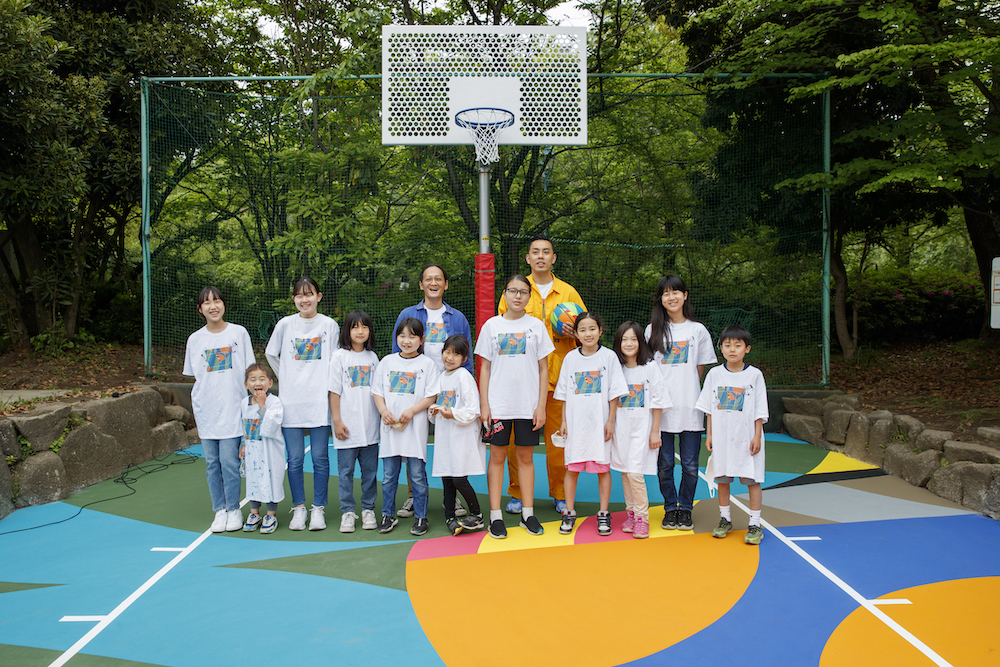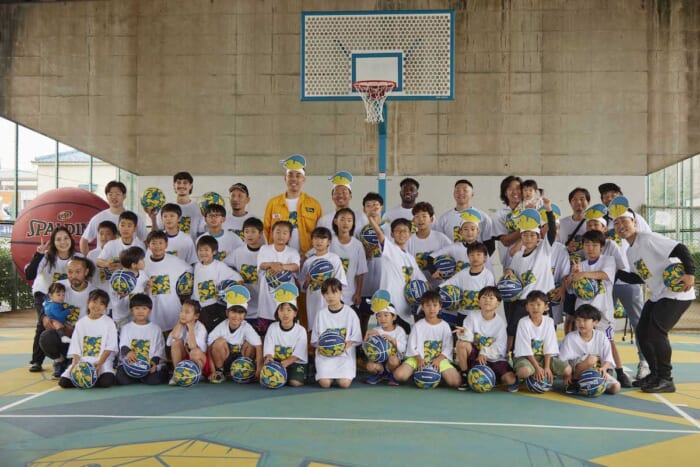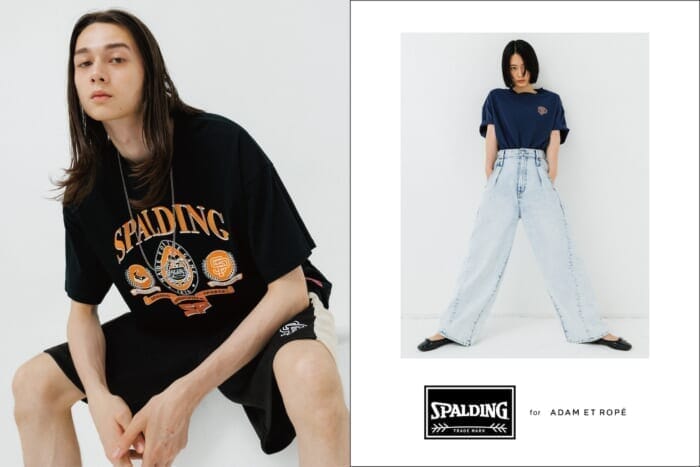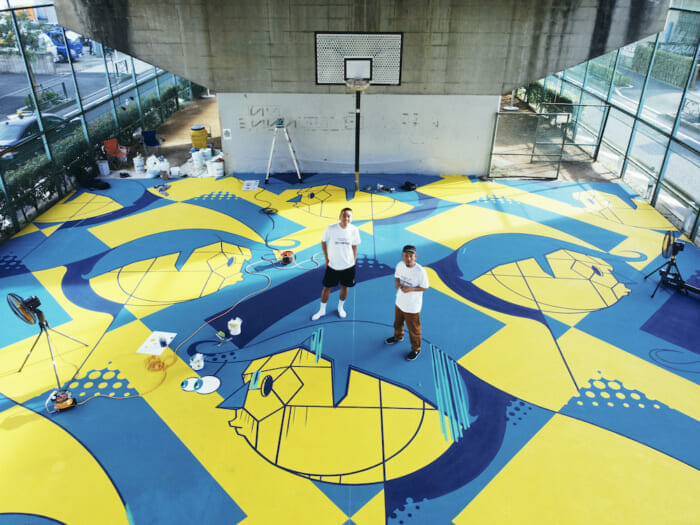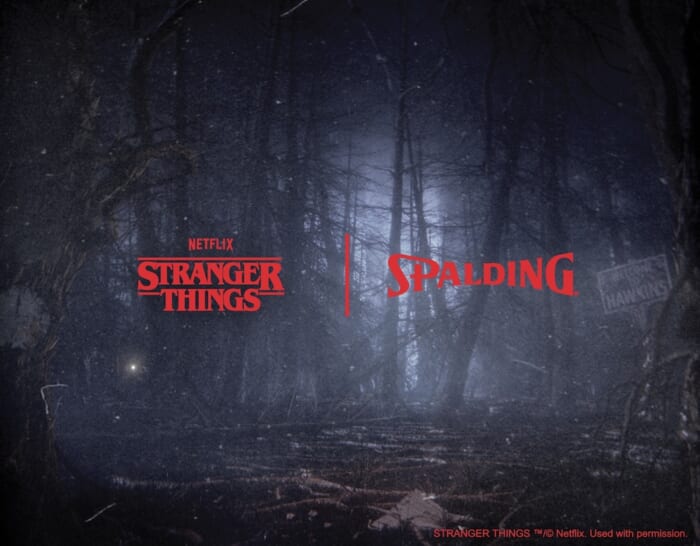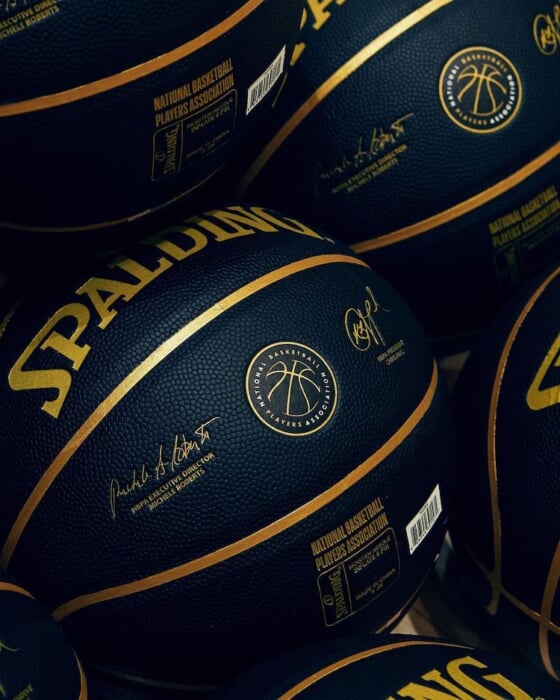The basketball scene has a population of about 450 million people around the world. The number of fans and the number of players continues to grow every year in Japan as well, thanks to the popularity of the game among younger generations, the success of Rui Yamura in the NBA, and the ever-increasing popularity of the B-League. Many people are looking forward to the movie "Slam Dunk," which is scheduled to be released this fall.
As if to spur on such basketball popularity, a very unique project has been launched. The project was initiated by a general incorporated association, "go parkey." This organization connects artists and local residents through the renovation of a basketball court in the park, creating an "art court" with the entire community.
The first pin in Japan was placed in Hamacho Park, Chuo-ku, Tokyo. The park's "go-parkie" approach was sympathetic to the "go-parkie" movement.SPALDINGand contemporary artists.Shunsuke ImaiThe basketball court, which had been loved by residents for many years but had deteriorated over time, was renovated together with kids who live in Chuo City. The court was renovated as a colorful art court with the help of children who live in Chuo City.
To review the activities of the project, we spoke with Mr. Sho Ebihara, the representative of "Go Parky," which is at the root of the project, Mr. Shimizu of the Spalding marketing team, and Mr. Imai, who drew the inspiring artwork.
Street culture called Art Court.
From left, Sho Ebihara, representative of "Go Parky,
Kenta Shimizu, Marketing Specialist, Spalding Corporation
First of all, what kind of organization is "GoParky"?
Ebihara: Simply put, we are an organization that renovates a basketball court in a park to make it beautiful with the power of art. The artists will drop their designs all over the floor and work with local children in the process of painting the floor. In other words, the essential aim of the project is to create and revitalize together with the local residents.
I see. So you intend not only to revitalize the court, but also to revitalize the town as a whole.
Ebihara: That's what I mean.
What was the story behind the launch of "Go-Parky" in the first place?
Ebihara: Since 2018, there has been a growing trend in the U.S. and other countries to renovate basketball courts by combining art. I myself started playing basketball on a court in a park, and it is a place that I have a lot of personal attachment to, as I met many people there.
. So, I wanted more attention to be paid to the park's courts, and I became more and more interested in making more people aware of their charm. . Then I learned about renovation activities and decided to launch them in Japan.
How widespread is the art court culture abroad today?
Ebihara: I have seen them in Europe, and in the U.S., there are about 50 that I know of. I think it will continue to spread.
How about Japan?
Ebihara: There are courts with design elements, but there are no courts in the context of so-called renovation, or in the concept of artists and local people working together to create something new.
. In that light, I guess you could say that Hamacho Park was the first Art Court in Japan.
Ebihara: Yes, that's right. Furthermore, this is a public basketball court managed by the ward . I think it is unprecedented for a private organization to be involved in its renovation, even in other public facilities.
. to express the infinite possibilities of art in a public space.
A: Spalding is also participating in the "Go-Parky" initiative, but how exactly are you involved?
Shimizu: Spalding was born in 1876 and has a history of about 150 years. Toward the next 150 years, we launched the "PASS FOR THE FUTURE" project under the theme of "sustainability," and were planning to create an environment where everyone can enjoy sports.
As part of that, the U.S. headquarters renovated "Rucker Park" in New York, the sacred place of street basketball, with the "NBA Players Association". So, what should we do in Japan? When we were thinking about this, Mr. Ebihara, who had been a close friend of ours for some time, consulted with us and we decided to participate in the project in the form of sponsorship.
Why did you choose Hamacho Park as the first site for this project?
Ebihara: Actually, this is a place with which I have a personal connection. In my previous job, I was in charge of overseeing operations for the Tokyo 2020 three-man basketball tournament, and the Chuo City Gymnasium in Hamacho Park was the official practice venue.
At the time, I was in charge of preparing the practice venue together with the people of Chuo Ward, and we even had a plan to give origami cranes made by the children of Chuo Ward to the players to encourage them, but the plan was scrapped because of Corona.... But at that time, I had already conceived the idea of "Go Parky," and I thought that if we created an art court here, we could leave the children's wishes as a legacy. It took a lot of work to make it happen, though (laughs).
Why did you offer Shunsuke Imai the opportunity to create the artwork?
Ebihara: "Go Parky" has many different members. Each has his own specialty, some specialize in photography , others in creativity. With a diverse group of members, we brainstormed and brainstormed, and decided that Hamacho seemed like a good location! Then who should be the artist? Then who would be the artist?
. When we all looked at the work together, the image of the finished product came to me easily. . I am not an art college graduate, but I felt something instantly. . I thought that feeling was the real thrill of art, so I immediately made an offer to Mr. Imai.
. I think I know what you mean about that instantaneous feeling of excitement.
Ebihara: However, our goal is not to pursue design, but to create a new community with a clean court. We want people to be stimulated from various angles through the art court, such as people who are just starting to play basketball, or people who were only interested in basketball but now want to try painting.
In my mind, a basketball court in a park is a place where you can meet people from all walks of life, make friends, and even play basketball with adults. It is a dynamic place where you can meet all kinds of people, make friends, and even play basketball with adults. The infinite possibilities of art in a public place . This is a theme that I would like to keep in mind.
How about you, Shimizu?
Shimizu: Having lived abroad myself, I was very happy to be able to play basketball in a public place. I had the feeling that if we combined a basketball court and graffiti art, we could definitely create something good, so I was determined to support the project not only as an individual but also as a company.
So you have a good relationship with each other. What kind of place do you both want Art Court to be?
Ebihara: I hope that this place will be a catalyst for positive energy that will help the community rise above generational and racial barriers.
Shimizu: With Mr. Ebihara, I would like the entire community to become a hub spot where everyone can connect.
By the way, have you decided on the second issue yet?
Ebihara: It has been decided, but due to circumstances, I can't announce it yet. However, I am sure that the next project will be just as wonderful as this one, so please look forward to it.
So far, we have asked Mr. Ebihara of "Go Parky" and Mr. Shimizu of "Spalding" about the process of creating the Art Court at Hamacho Park and their vision for the future. From here, we would like to delve deeper into the character of Mr. Imai, the artist who created the artwork.
Whether you can always excite yourself.
. First of all, please introduce yourself to the readers of HOUYHNHNM.
Imai: Well, I am a painter. . Basically, I paint abstract paintings with crisp color surface compositions.
What made you decide to become a painter?
Imai: My father was an art teacher at the high school I attended, and we both went to the same high school. When I narrowed down the choices of which departments I wanted to go to and which I did not want to go to, art was the only one that remained, so I went to art school. Also, I grew up in an environment where I was surrounded by "making" and "seeing" from a young age, and art magazines were like picture books for me, so I naturally chose a career in art.
A. How long have you been active now?
Imai: It depends on where you want to start, but it has been 15 years since I started showing my work in a proper gallery.
Are you the first artist to create art on the walls and grounds of a public facility like this?
Imai: It no longer exists, but there is an art-related facility called "YCC" in Yokohama, and I once painted a graphic on the wall of its 6 x 8 meter entrance. It was the second time I painted graphics on the entrance wall, following the work of pasting in printouts.
Imai-san's works are drawn with flowing lines, and I thought that they could be seen in many different ways depending on the viewer. If you were to verbalize your own work, how would you describe it?
Imai: It's very difficult, but if I had to describe it in one word, it would be art. . I am particularly influenced by American postwar art. Abstract expression has existed for more than 50 to 60 years, and I paint while thinking about how I can update it.
However, since most people see these works without knowing anything about history, I think it would be better if they simply enjoy them by saying how beautiful they are, how big they are, or how much depth they have even though they are flat. And if they become interested in that, they will wonder what this person is doing and begin to understand one more level of the hierarchy in depth. I hope that by studying in this way, people will get to know various artists, and I hope that I can be a catalyst for that.
In other words, I want people to feel that this art is interesting at first glance! and then get more and more into the depths of the art.
Imai: Yes, that's right. I would like to see more people like that.
How do you see the current art scene, where the value of art as an asset is on the rise?
Imai: I think it is a good thing that the number of people who have access to art is increasing, but there is a lot of art out there, regardless of trends, and if people think that only what is popular is art, it will taper off as a culture. It would be good if people knew that there is more than just famous works of art.
If art courts were to spread, Japan would be a much more enjoyable place to live.
What is the most important thing for you in your own expressive activities?
Imai: It is a matter of course, but you have to keep going. As you continue to create similar works, your skills will improve, but there will definitely come a moment when you get tired of it. Even so, I always try to keep on doing one thing that I feel is exciting, and then I move on to the next work. I always keep in mind whether or not I can excite myself while using the next work as a hint for the next one.
In that sense, were you excited when you heard about this project?
Imai: I felt intuitively that something interesting was in store. I was skeptical at first, but when Mr. Ebihara explained it to me, I thought, "Ah, I see. I thought it would be great to have a picture of myself painted all over the floor, with various people happily playing basketball on it. It may get dirtier and dirtier, and one day it may disappear, but I think that is also meaningful.
. You are playing on the picture that you have painted.
Imai: It's a very rare experience, isn't it? But I think it's interesting.
What do you envision in this painting?
Imai: Japan is a country with a lot of greenery, so I tried to combine colors that do not exist in the natural world, based on that kind of coloring. . I wanted to create something that would blend in with the park, while still feeling strange.
Q: Did you encounter any difficulties in painting on the limited floor space of the park's court?
Imai: I had no experience in painting on the floor, so I did not know what steps to take until I tried it, and it was very difficult because it was inevitably affected by the weather. The scale of the project was different, and the materials used were also different.
Do you have any insights from your participation in the project?
Imai: The process leading up to the production was interesting, as it involved listening to the requests and fulfilling my own ideals. . For example, I may think a color combination is beautiful, but it may not be considered so by the general public.
I realized that I had a lot to learn. To put it another way, visitors to my exhibition would not say, "I don't like this color combination," nor would they say so (laughs). (laughs). I learned a lot from this experience in terms of taking each other's opinions into consideration.
What do you want to see happen to the town and the park as a result of the new Art Court?
Imai: I would be happy if it becomes a scenery for people who enjoy playing basketball here. I hope it will become so commonplace that people will say, "Hama-machi Park is where that basketball court is located, right? I hope it will become so commonplace that people will say, "Hamacho Park is where that basketball court is located! Also, now that the court has been beautifully maintained, people who play basketball here may develop a desire to keep the court clean. I hope this will be a good opportunity for them to do so, and I think it will be even more fun if the art courts spread throughout Japan as a sample of what can be done.
The Hamacho Park Basketball Court, the setting for this project, is located near the Tokyo Bay, surrounded by beautiful trees and sea breezes, and has long been a favorite place for local residents. This historic court was given a new lease of life as an art court through the collaboration of "Go Parky," "Spalding," and Mr. Imai. A fusion of street basketball and art. This unlikely combination may become an indispensable part of the next generation of community building.
Text_Jun Nakada
Photo_Yutto
Material photo courtesy of _go parkey
Outdoor basketball court at Hamacho Park, Chuo-ku, Tokyo
Address: Hamacho Park, 2-59-1 Nihonbashi Hamacho, Chuo-ku, Tokyo
Sponsored by:General Incorporated Association go parkey
Sponsored by:SPALDING
Supported by: Chuo City Office
Instagram:
@go_parkey
@spalding_japan
@imsn
ART COURT by go parkey Products
In conjunction with the release of the Art Court, Spalding has collaborated with Go-Parky on a new line of goods. The colorful, pop-up No. 7 basketball and micro-mini (miniature goal and ball), featuring the same design as the Art Coat, have been produced. The release is scheduled for 2023.


